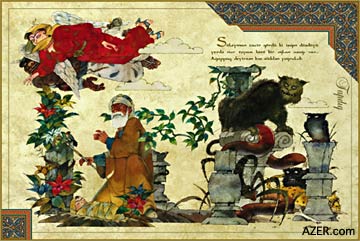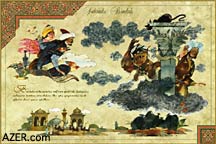|

Winter 2004 (12.4)
Pages
72-73
Heirloom Book Published
Scary Tales Our Grandmothers Told Us
by Gulnar
Aydamirova and Aytan Aliyeva

Above:
The new Fairy Tale book,
Mystic Tales (Sehirli Naghillar) published by Tutu Publishing
House. Nusrat Hajiyev did all the llustrations. UNOCAL and STATOIL
sponsored the project.
Finally, there's a fairy tale book published in Azerbaijan of
such beauty and elegance, that it's worth passing down as an
heirloom, generation after generation. Tutu Publishing House
has just come out with a 240-page, oversize, full-color, fully
illustrated, gilt-edged hardback volume called Mystic Tales.
This beautiful edition just won the top prize for "Craftsmanship"
at the major Big Book Exhibition held in Moscow this past July.
"This was an important victory for us and for Azerbaijan,"
said Tarlan Gorchu, Artistic Director and driving force behind
Tutu Publishing. "It proves that although we are experiencing
difficult times in publishing, we do have talented artists, writers,
and designers who can produce books that win fiercely competitive
prizes at international exhibitions."
Several years ago, when the Mystic Tales project was being conceived,
Mike Barnes, Manager of Unocal Khazar in Baku, got involved and
understood its unique legacy to folklore and artistic literary
endeavors in Azerbaijan. Together with Statoil, these two oil
companies provided the economic support, which gave birth to
this milestone.
  Left: Latest project of Tutu Publishing House: an heirloom
gilt-edged book of fairytales in full color and fully illustrated. Left: Latest project of Tutu Publishing House: an heirloom
gilt-edged book of fairytales in full color and fully illustrated.
Fairy tale books have always been very popular in Azerbaijan.
Even during Soviet times when thousands of books were published
each year, such books, even those of lowest quality were in high
demand, according to Tarlan. Even when other books remained on
the shelves, fairy tales sold quite easily since folklore is
an integral part of life. Every child grows up listening to fairy
tales told by their mothers and grandmothers.
"Our aim was to publish the most monumental book ever produced
about Azerbaijani fairy tales," said Tarlan, when describing
his vision for the book. "That's why we decided not to rush
this job." Indeed, it ended up taking one year to select,
rewrite and edit the 12 tales, and two more years to create the
art work and design the book.
"Since there are so many fairy tales in Azerbaijan, we knew
we couldn't publish all of them," said Tarlan. "That's
why we decided to concentrate on 'mystic tales', which are full
of supernatural elements, including divs (monsters).
That's when they consulted Maharram Gasimli, Director of the
Literature and Folklore Department at the Academy of Sciences,
along with Ilham Rahimli and Zeynal Mammadli. Most of these Azerbaijani
fairy tales had been collected during the 1920s and 1930s. Unfortunately,
during that period, personal tape recorders did not exist that
would have guaranteed the authenticity of the tales. Folklorists
were sent off on expeditions to remote areas to collect the tales.
However, their methodology was dubious. They knew that they would
be paid according to the quantity of pages they produced so there's
no wonder that they lent a hand to enhance and expand the stories
themselves. On other occasions, some of the tales were modified
or censored because they did not fit the strict guidelines of
Soviet ideology, in terms of Socialist Realism where contentment
was supposed to have spread throughout the land.
  Of course,
the original version of such stories can rarely be traced, and
it's only natural that each storyteller always injects his or
her own vision of reality and world experience into the telling
of these tales. These are natural processes that take place in
any oral medium any place in the world. Of course,
the original version of such stories can rarely be traced, and
it's only natural that each storyteller always injects his or
her own vision of reality and world experience into the telling
of these tales. These are natural processes that take place in
any oral medium any place in the world.
Mystic Tales is based upon TUTU staff's own literary tastes.
The twelve folk tales that were selected are: Bakhtiyar, Divbecha,
Pari khanim (Mrs. Pari), Malikmammad, Dash uzuk (Stone ring),
Shahzade Bandali (Prince Bandali), Tapdig, Ayghir Hasan (Stalion
Hasan), Nar Giz (Pomegranate Girl), Guru Khala, Ibrahim, and
Goychak Fatma (Pretty Fatma; an Azerbaijani version of the well-known
fairy tale, Cinderella).
Tarlan based the design of Mystic Tales on the Koran. "It
is our Holy Book and is always revered and treated with care;
you can never knowingly allow it to get damaged. The most talented
artists are always involved in the design. That's exactly what
we wanted for Mystic Tales. We wanted to convey the importance
of this book through its design."
Publishers in Azerbaijan have fallen on hard times these days.
It's economically very difficult for them despite the desperate
need for books to be printed in the new modified Latin script
that was adopted a few weeks after Azerbaijan gained its independence
from the Soviet Union. Fourteen years later, there are still
only a few books available in the new alphabet.
During Soviet times there were hundreds of bookshops in the city.
Most have closed; a few dozen remain open. Demands for sales
have declined dramatically. "We can't gain enough profit
from sales to reinvest in new projects," says Tarlan. "Books
are not being propagated in our country."
  Left: Illlustrations by Nusrat Hajiyev. Visit: AZgallery.org. Left: Illlustrations by Nusrat Hajiyev. Visit: AZgallery.org.
Tutu Publishing has produced more than 50 books since they were
established in the early 1990s. They had already published two
beautifully illustrated series of fairy tales when they undertook
this project. River of Fairy Tales is a series of 16 booklets
(16 pages each), which feature tales collected from around the
world. This series includes German, Chinese, Eskimo, Swedish,
Indian (continental), Scottish, French, American and Azerbaijani
tales. They are published in the Azeri language in the new modified
Latin script.
Native Garden of Fairy Tales is a series of five tales representative
of national minorities that make their home in Azerbaijan. This
series includes tales from Talish, Avarian, Kurdish, Lezgin,
and Jewish traditions. Each story is bilingual, published in
its native language and script, along with an Azeri translation
in the new Latin script.
Tutu Publishing is currently working on a large format coffee
table book, featuring photos of the Shaki Khan Sarayi (The Khanate
Palace in the town of Shaki located in the foothills of the Caucasus
in northwestern Azerbaijan). Previously, they published an extraordinarily
beautiful volume about Baku featuring the photography of Farid
Ashrafoglu (2001). They also did the art work for the 6CDs and
book written for the Vagif Mustafazade Mugham Jazz project. Tarlan
has dreams for Mystic Tales to be published in English one day
because he believes there is great interest among the Azerbaijani
community within the country as well as those abroad. Native
English speakers are also showing interest in the book as well.
Back to Index AI 12.4 (Winter
2004)
AI Home
| Search | Magazine
Choice
| Topics
| AI Store | Contact us
Other Web sites
created by Azerbaijan International
AZgallery.org | AZERI.org | HAJIBEYOV.com
|